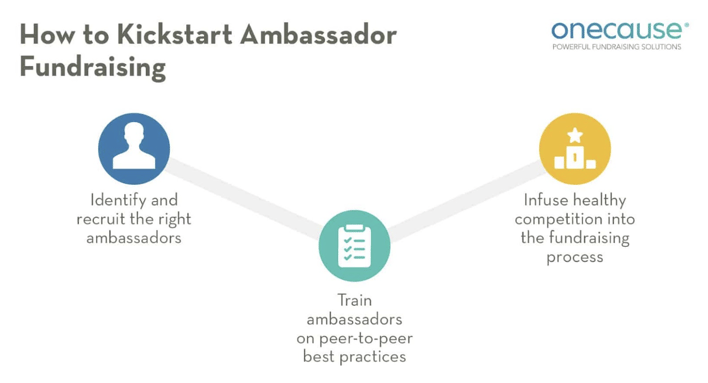If your nonprofit is looking for a way to get the word out about your cause and grow your community of loyal supporters, look no further than an awareness campaign. Also known as an advocacy campaign, an awareness campaign is aimed primarily at increasing public visibility of your cause.
This usually means that your nonprofit is working to spread the word about your mission, why it matters, and why donors should get involved, but it can also cover a wider variety of objectives, depending on your nonprofit’s strategic plan.
To maximize your awareness campaign’s success, you need to set realistic targets that will keep your entire team motivated and push you to make the most of your efforts. Use these tips to set measurable goals that will help put your organization on the map and take your mission to new heights.
Take a Deep Dive into Your Past Performance
Performance data from a past awareness or fundraising campaign can be the best starting point for creating actionable and reasonable goals for your upcoming campaign. Take a look at metrics like:
- Your social media follower growth
- Website metrics (such as page views, bounce rate, and conversion rate)
- Email marketing engagement metrics (such as open rate, clickthrough rate, and unsubscribe rate)
- Number of peer-to-peer participants
- Number of new volunteer sign-ups
- Number of new donors
As you reflect on past performance, be sure to think through what strategies worked in your favor and what didn’t and use this information to guide your planning.
If you sent out feedback surveys during your past fundraising or awareness campaigns, consider incorporating your supporters’ suggestions into your new awareness campaign plan. This can point you in the right direction so your campaign activities align with supporters’ interests.
Follow the SMART Model
The SMART (specific, measurable, attainable, relevant, and time-bound) goal-setting model can help you create actionable goals that lay out a clear roadmap for your nonprofit to achieve success. Let’s take a look at what the SMART model might look like in action for your awareness campaign:
- Specific: Our nonprofit will maximize our impact and reach by growing the number of peer-to-peer participants during our awareness campaign. We’ll achieve this by partnering with fundraising ambassadors, leading an engaging social media marketing campaign to bring attention to our peer-to-peer fundraiser, and launching a well-designed microsite that we will promote across all channels.
- Measurable: Our goal is to increase the number of peer-to-peer participants by 30% compared to the previous campaign.
- Attainable: During our last campaign, we increased the number of peer-to-peer participants by 15% when we ramped up social media promotion for our awareness campaign. By partnering with fundraising ambassadors and creating an engaging campaign microsite, it is well within our reach to increase the number of peer-to-peer participants by 30%.
- Relevant: Increasing our number of peer-to-peer participants will help grow our network of supporters, bringing more visibility to our cause. Plus, we’ll be able to raise more funds and accelerate our mission in the community.
- Time-bound: Our peer-to-peer campaign will take place over a period of 6 weeks. We’ll check in on our progress each week and adjust our strategies as needed to maximize our chances of success.
If you’re thinking of adding a peer-to-peer component to your awareness campaign, start by recruiting ambassadors to help get the word out. Ambassadors are the social butterflies of the fundraising world; these individuals have large networks and can easily amplify your message to brand new audiences.
To get started with ambassador fundraising, consider these tips:

- Identify and recruit ambassadors who can effectively expand your reach. Begin by looking among your staff, volunteers, board members, and corporate sponsors.
- Train ambassadors by providing a toolkit with messaging examples, social media post templates, advice on how to push fundraising goals forward, and whatever else they may need to ensure your peer-to-peer campaign is a success. Double the Donation’s guide to volunteer management also recommends assigning a point person that your ambassadors can turn to with any questions so they can step into their roles with confidence.
- Infuse healthy competition into the fundraising process by rewarding the fundraising ambassador who raises the most funds a special prize, such as branded nonprofit merchandise.
As you roll out your ambassador fundraising, remember to assign clear responsibilities so ambassadors know their specific roles in helping you achieve your goals.
Track Progress and Reflect on Results
With your team, identify benchmarks so you know whether you’re on track to meeting your awareness campaign’s goals. Use reliable fundraising software to closely follow incoming data and make changes as needed in real-time so you can increase participation.
If your nonprofit is struggling with engagement, try out one of the following strategies:
- Use compelling storytelling: As you market your awareness campaign across multiple platforms, tell high-impact stories that show why your organization is worth supporting. Use visuals that will inspire your audience and prompt action.
- Leverage gamification: If you’re coupling your awareness campaign with a peer-to-peer campaign, add gamification tools with the help of your fundraising software. For example, you might feature a fundraising thermometer on your microsite that shows campaign progress or encourage supporters to compete to raise the most amount of funds by displaying a leadership scoreboard.
- Add an event: Deepen your supporters’ connection to your cause with events that help them learn more about your mission. For example, you might host a webinar with experts that can provide additional insight into the issue your nonprofit is tackling. Or, the OneCause guide to walkathons recommends coupling your peer-to-peer campaign with a walkathon to boost engagement and get your community up and moving for a great cause.
After your campaign wraps up, your job isn’t done! Make sure to send out feedback surveys to key stakeholders so you can determine ways to improve your awareness campaigns in the future.
Not only will this give your nonprofit an excellent starting point for your next campaign, but it lets your supporters feel involved in the process as well. Building trust is a large component of donor loyalty, and bringing them in to assist with future campaigns creates a strong foundation for a good relationship.
Wrapping Up
Awareness campaigns are one of the most popular ways to bring public visibility to your nonprofit’s cause. To strengthen your campaign plan, you’ll need to determine your key performance indicators and develop an action plan outlining how you’ll work to achieve these numbers.
Remember that raising money isn’t the core focus of your campaign. Awareness campaigns should be centered on messaging and growing your audience. If you don’t have strong messaging, your campaign can fall flat, so be sure to focus on spreading the word and the donations will follow!



COMMENTS